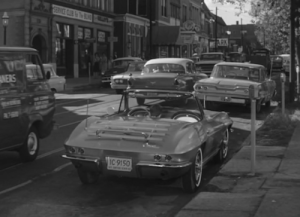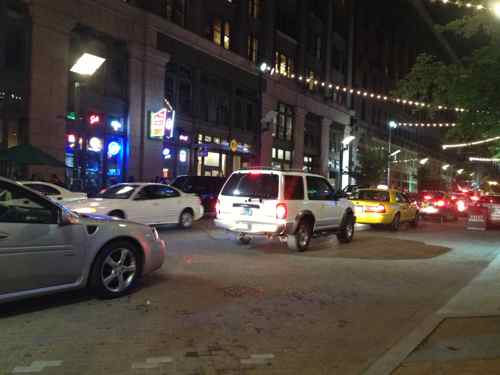Gaslight Square vs. Washington Ave

When I moved from Oklahoma City to St. Louis in 1990 our long-time neighbor across the street told me of his visits to Gaslight Square in the 1960s. By the time I’d arrived the buildings on the 2-block stretch of Olive were boarded up. I settled just West of there, on Lindell near Euclid. Euclid Ave, in the 90s, seemed to attract crime. Now it’s the greater downtown area — specifically Washington Ave.
First, a look at Gaslight Square:
By summer 1960, it was the place to be for beats, preppies, well-dressed adults, street troubadours and tourists. Olive pulsed with a happy cacophony wafting from places called the Crystal Palace, Left Bank, Laughing Buddha, and Dark Side. Jack Carl dished pastrami and genial abuse at 2 Cents Plain. A row of columns outside Smokey Joe’s Grecian Terrace anchored the landscape.
On March 24, 1961, the St. Louis Board of Aldermen anointed the obvious by renaming two blocks of Olive as Gaslight Square. Laclede Gas Co. later installed 121 gas streetlights, adding flicker to the buzz.
By summer 1961, Gaslight was noisier with more restaurants, taverns, nightclubs and shops. Some of the antiques dealers were squeezed out by rising rents. “The old gang doesn’t come around anymore, but perhaps it is a necessary evil of growing,” Massucci said as cash registers jingled.
Big and future names in show biz played the square. An 18-year-old singer named Barbra Streisand was warm-up for the Smothers Brothers. Allen Ginsberg recited poetry to mellow jazz. Miles Davis and Singleton Palmer were regulars. Earnest ministers opened the Exit, a coffee shop promising meaningful discussion and “jazz liturgy.”
But the crowds also attracted purse snatchers, car thieves and worse. On Dec. 30, 1964, Lillian Heller was fatally shot in a robbery in the vestibule of her apartment building at 4254 Gaslight, just east of Boyle. Heller, 61, and her husband, John, were artists.
Police added patrols and promised security. Young people flocked to discotheques such as Whisky a Go-Go, where hired dancers gyrated on platforms. But throbbing recorded music was drowning the live clarinet riffs. It became too crass and too much.
The old clubs began closing. Laclede doused some of the gas lights in 1967 for failure to pay. Police made drug arrests and thwarted a desperate bid to save the strip with topless waitresses. The Exit gave up the spirit in 1969, about when cultural pathologists pronounced the end of Gaslight. (Post-Dispatch)
Gaslight Square concentrated a lot into a couple of blocks of Olive. This concentration of money and activity attracted those who wanted some of that money. Rising crime became too much for some so it began to die.
There are parallels to current events, but there’s time to avoid going down the same path. Ever since the Washington Ave streetscape was completed about 15 years ago (Tucker to 18th), so much attention has been focused on a tiny area.

The solution is to put less focus on Washington Ave, but also do like many cities: divide downtown/downtown west into geographic districts. Examples: Toronto, Oklahoma City, Kansas City. This has been talked about for years but it has never happened.
Some possible districts include:
- Garment District
- City Museum District
- Ballpark Village District
- Convention District
- Union Station District
- Columbus Square District
- Library District
- Central Business District
- Arch District
- MX District
None should have “downtown” or Washington Ave” the name. Sure, crime will still happen, but this way an entire area won’t get stigmatized by something that happens 1-2 miles away. Branding districts could help with marketing efforts.
— Steve Patterson
One, I think the current district names have something to do with census tracts, and from my experience are a) hard to change, and b) only well-known to very-local residents and/or policy wonks. Around St. Louis, most people identify more with their parish and/or ward far more than they do with some planning department name or arbitrary boundary. Two, most media outlets don’t do a very good job of using planning department names, anyhow, and most people have a pretty broad view of “downtown”, encompassing everything from Old North to Benton Park and from the river to Jefferson. People aren’t afraid of crime because of an arbitrary name, they’re afraid of crime because they hear about it, repeatedly, on the news. North city, north county, the state streets in south city and, more recently, the Loop and the Bevo Mill area are all stigmatized just like “downtown” is, when it comes to crime. Sure, putting lipstick on the pig will help, a little, but reducing the actual crime rate will help a whole lot more!
Uh…we have no current district names. None. Census tracts are numbered, not named. See http://www2.census.gov/geo/maps/dc10map/tract/st29_mo/c29510_st_louis_city/DC10CT_C29510_001.pdf
They track for downtown (#1256) looks to be the same as the downtown neighborhood boundaries. Census tracks have nothing to do with the kind of districts identified in other downtowns.
Downtown and Downtown West is a big area, they need to smaller geographic identities within the neighborhood boundaries.
This is wrong. Downtown has multiple official district names already. They’re just rarely used, because it’s far too small an area to be successfully divided in the public imagination. It’s only a square mile, that’s on the small side for a neighborhood already. For people who don’t live nearby, “downtown” generally means something much bigger than the official definition- everything east of Grand, or east of Kingshighway, or the whole City. You’re not going to get non-locals to care about the distinction between a few blocks, any more than a non-native New Yorker can tell you the difference between Murray Hill and the UES.
Please reply with a link to the official map showing the districts then. Hint: it doesn’t exist.
https://www.stlouis-mo.gov/government/departments/planning/documents/upload/CitywideNeighborhoodMap.pdf
That’s the neighborhood map. A district plan would subdivide the large geographic Downtown/Downtown West neighborhoods.
Now you’re getting into semantics. To most people, including those who define words, they’re pretty much interchangeable (from the Google):
dis·trict – ˈdis trikt
noun – an area of a country or city, especially one regarded as a distinct unit because of a particular characteristic. “an elegant shopping district”
synonyms: neighborhood, area, region, locality, locale, community, quarter, sector, zone, territory
neigh·bor·hood – ˈnā bər ho͝od
noun – a district, especially one forming a community within a town or city. “she lived in a wealthy neighborhood of Boston”
synonyms: district, area, locality, locale, quarter, community
Taking things a step further, I asked the Google what the differences may be and did find the following:
The Neighborhood, the District and the Corridor, by Andres Duany and Elizabeth Plater-Zyberk
“The fundamental organizing elements of the New Urbanism are the neighborhood, the district and the corridor. Neighborhoods are urbanized areas with a balanced mix of human activity; districts are areas dominated by a single activity; corridors are connectors and separators of neighborhoods and districts.”
“A single neighborhood standing free in the landscape is a village. Cities and towns are made up of multiple neighborhoods and districts, organized by corridors of transportation or open space. Neighborhoods, districts and corridors are urban elements . . . ”
http://www.csus.edu/indiv/s/shawg/courses/154/articles/tnu2.pdf
I wonder if residents would ever identify with a given district name, “Garment District”, for example. And when someone would refer to it either in conversation or in writing, would they feel compelled to clarify exact location: “….a burglary was reported in the “Garment District” last night, that’s the area of downtown St Louis on Washington Avenue, between 8th and 12th Street…”???? I think it will be hard to shake the stigma that downtown St Louis/Washington Ave is swiftly becoming a high-crime area, whether you divide the area into block-long districts, or just keep it the way it now is. I know that I no longer patronize the taverns and restaurants on Wash Ave when I’m visiting St Louis. I typically entertain clients either on the Hill or in Dogtown, where the food is better prepared and a far better value, IMO. I always especially enjoy the genuine friendliness and hearty welcomes in Dogtown.
Our current neighborhood identities were created in 1989 during Schoemehl’s last term as mayor, that has worked just as districts have worked for other large downtowns.
Personally I think the naming of districts comes after it is apparent what they are. I believe the planners tried to name the area outside the proposed new Rams stadium proposal the imagination district or something odd like that.
The idea of district might help is some cases, like Grand Center Arts District, but basically the problems are more basic:, jobs, good urban planning and so on. Not sure how it would impact crime perception though.
Generally speaking I think designations are earned rather than bestowed, especially in dynamic city situations.
Now if a program of designations included some kind of identity routing on the part of the transit system, then districts designations could become more useful, such as “I’ll meet you at the Kremlin Square Station.” The station represents a district.
The area already has names. They are based on nearby landmarks. “Union Station”, “Ballpark Village”, “Old Post Office (Square)”, “Wash Ave”, “Midtown Alley”, “Arch”, “Laclede’s Landing”, “Convention Center”. That’s basically it. Say those names, and most people in our region know which “district” you’re referencing.
Visitors don’t know where things are, if you look at the examples I linked to you’ll see where other cities formalize what we know. This is helpful for wayfinding — important for anyone not familiar with the area.
Even people who live in the St. Louis region might not know what’s not far from Busch Stsdium, such as the Blue’s Museum in what I’d call the MX District.
I really think this is just semantics. Which is more important, the landmark or a “district name”? People want to visit landmarks, or perhaps districts/zones. But in the case of downtown St. Louis, the only real “district” is Washington Avenue. It’s a landmark street and a destination. Back to my previous comment, I left off one important landmark – City Museum. Again, what would you call the district home to City Museum? “City Museum District”? It’s a distinction without a difference. Call it something else and you’d create more confusion, not less. “Go to the Washington Avenue Zipper DIstrict to visit City Museum”? Seems pointless.
Oh, and other, “Laclede’s Landing”. It’s a branded district. And it’s struggling. Being branded doesn’t seem to help the area.